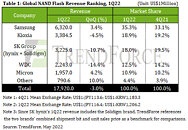Inventory Headwinds Weigh on Top 5 Enterprise SSD Vendors in 1Q25; Recovery Expected as AI Demand Grows
TrendForce's latest investigations reveal that several negative factors weighed on the enterprise SSD market in the first quarter of 2025. These include production challenges for next-gen AI systems and persistent inventory overhang in North America. As a result, major clients significantly scaled back orders, causing the ASP of enterprise SSDs to plunge nearly 20%. This led to QoQ revenue declines for the top five enterprise SSD vendors, reflecting a period of market adjustment.
However, conditions are expected to improve in the second quarter. As shipments of NVIDIA's new chips ramp up, demand for AI infrastructure in North America is rising. Meanwhile, Chinese CSPs are steadily expanding storage capacity in their data centers. Together, these trends are set to reinvigorate the enterprise SSD market, with overall revenue projected to return to positive growth.
However, conditions are expected to improve in the second quarter. As shipments of NVIDIA's new chips ramp up, demand for AI infrastructure in North America is rising. Meanwhile, Chinese CSPs are steadily expanding storage capacity in their data centers. Together, these trends are set to reinvigorate the enterprise SSD market, with overall revenue projected to return to positive growth.




































